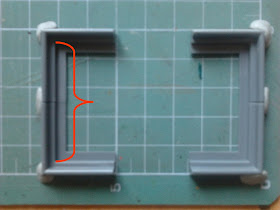Before we start, please excuse the quality of the pictures. My camera is at the moment dead and I had to use my phone. Very, very sorry.
Some posts ago I discussed movement trays and confessed my deep love for the Modular Tray system by GW. I firmly believe it to be one of the best products The Company makes. Yes, it's "just" for WFB, but it really, really shines here. Movement trays aside, this system is also very useful for all your non-standard bases: giants, war machines (if you are like me and use bases for them) and things like three-beast chariots. Moreover, I think I'll make these for my regular chariots and maybe even the arachnarok. I like my big models on very solid bases.
So, where do we start? With the materials of course! You will need:
- Modular Movement tray system, or rather just the border bits, there are always lefotvers
- 2mm thick polystyrene
- 1mm thick polystyrene - optional
- a cutting mat with metric measurement - nonessential, but hugely helpful
- model putty - any sandable kind will do, this is not critical, but makes the base look much better
- a sharp knife
- a caliper - I use it, but it is in no way essential, you can just as well use a ruler
Step 2) - find your corners on the cutting mat:
...like so. If you have leftover corner bits, these are hugely helpful - they already have the perfect angle and stuck together they measure exactly 50 mm. If you are left with the straight bits, just cut them at a 45-degree angle. There's no need to be ultra-neat, but it helps.
Step 3) - add the first layer.
Here is where I used the caliper. I blu-tacked the bits to my mat and measured this distance (and of course the length as well, what we need here is the 'lower step' of the border bits):
This is our first 'layer'. Cut your 2 mm polystyrene to these measurements and glue it in. Allow to dry.
Once the glue bonds, you can remove the blu-tac.
Step 4) - add the second layer.
Repeat the above, again with the 2 mm sheet, just now we need the 'upper step' of the borders. The second layer is bigger than the first. See here:
Of course this goes for length as well. Glue on the second layer and press it firmly. Allow to dry.
Step 5) - add the rest of the borders and the final layer if you want.
Measure the gaps between the corner bits and cut the straights to size. Glue them on, allow to dry.
The top of this base is not flush with the borders, it still needs about 1 mm in height. You can leave it at that, but I added a third layer of 1 mm polystyrene.
Step 6) - fill and sand the gaps.
Fairly self-explanatory. I used Vallejo acrylic putty and two grains of sandpaper - 600 and 800. It really gives the borders a smooth, clean look; we want that.
Step 7) - prime, paint, decorate and base the model.
That's it. I know it looks time-consuming, but it really isn't, I made the base above in an hour or so. Bases made like this are very, very solid and rigid, they don't bend or depress like the hollow ones GW makes. 5 millimeters of plastic also give any pins plenty of space to glue into.
Another idea that came to me whilst making this base is that I can also make some depressions and gouges to simulate puddles and such. Something I will definitely try.
Hope this was helpful. See you next time!






No comments:
Post a Comment
Comments in English only please.